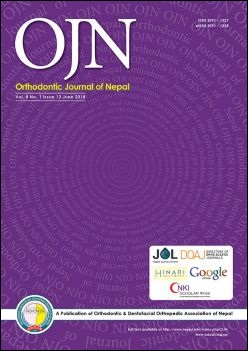Effect of Naso-respiratory Obstruction with Mouth Breathing on Dentofacial and Craniofacial Development
DOI:
https://doi.org/10.3126/ojn.v8i1.21343Keywords:
anterior oral seal, dentofacial growth, mouth breathing, malocclusion, nasal obstructionAbstract
Objective: To evaluate the effects of mouth breathing on craniofacial and dentofacial development during childhood in comparison to nasal breathing in malocclusion patients.
Materials & Method: A retrospective study done at SOA University. Cephalometric parameters and clinical variables of 90 pediatric patients who had undergone orthodontic treatment were reviewed. Study group included 40 pediatric patients who suffered from signs and symptoms of nasal obstruction, and control group included 50 patients who were normal nasal breathers. Dental and craniofacial parameters were compared between nasal breathers and mouth breathers using clinical and cephalometric records.
Result: The mouth breathers had backward and downward rotation of mandible with increased overjet, increased mandibular plane angle, higher palatal plane, and constriction of upper and lower arches at the level of cuspids and first molars when compared with nasal breathers group. The prevalence of posterior cross bite was observed greater in mouth breathers group (40%) than the nose breathers (20%) (p =0.006). Abnormal lip-to-tongue anterior oral seal was seen more in the mouth breathers group (55%) than in nose breathers group (25%) (p = 0.05).
Conclusion: Naso-respiratory obstruction with mouth breathing during growth periods in children has a greater tendency for clockwise rotation of growing mandible, with an irregular increase in anterior lower vertical face height and decreased posterior facial height.
Downloads
Downloads
Published
How to Cite
Issue
Section
License
Copyright © held by Orthodontic & Dentofacial Orthopedic Association of Nepal
- Copyright on any research article is transferred in full to the Orthodontic & Dentofacial Orthopedic Association of Nepal upon publication in the journal. The copyright transfer includes the right to reproduce and distribute the article in any form of reproduction (printing, electronic media or any other form).
- Articles in the Orthodontic Journal of Nepal are Open Access articles published under the Creative Commons CC BY License (https://creativecommons.org/licenses/by/4.0/)
- This license permits use, distribution and reproduction in any medium, provided the original work is properly cited.




